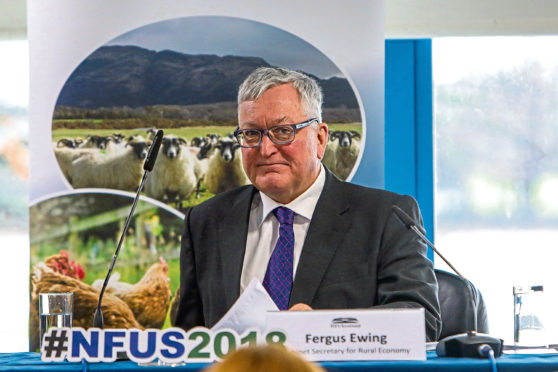As NFU Scotland (NFUS) president Andrew McCornick’s term of office draws to a conclusion, his frustration and anger at the Scottish Government’s lack of leadership at this critical time for Scottish agriculture boiled over in the AgriScot debate with Rural Economy Secretary Fergus Ewing.
In a hard-hitting speech, he called for the Scottish Government to “stop dithering and start delivering”.
“Where is the future policy?” he demanded.
Where is the road map to help Scottish farmers meet the multiple challenges of a Covid-wrecked economy and a climate emergency?
As the president pointed out, Fergus Ewing’s desk is buckling under the number of reports he and industry stakeholders have commissioned into the future path of Scottish agriculture.
Starting with the Pack report, then the Rural Advisers report, the Griggs report, the Rural Champions’ reports and now the Suckler Beef report and the Farming for 1.5 Degrees report.
So many trees cut down and so much carbon released in producing reports and yet most of them are gathering dust on the minister’s shelf.
His response to the NFUS criticism would be laughable if it were not so serious – he announced the setting up of yet another committee called the arable sector climate change review group.
Is it any wonder NFUS are frustrated?
Given the challenges Scottish agriculture faces at this time you would think any politician worth their salt would be champing at the bit to come up with Scottish solutions to tackle the problems farmers are facing.
Yet over the last four years the minister’s track record has been one of inaction and taking the easy option of kicking the can down the road.
He inherited a broken IT system from his predecessor, but despite his many claims that it has been fixed the reality is the £200 million system still can’t deliver farm payments on time.
Instead the Government hands out loans to farmers each year to cover up its complete failure to sort out the IT system.
The EU’s decision to close down Less Favoured Areas (LFA) schemes and switch to Areas of National Constraints (ANC) by 2020 has been well known to the Scottish Government for the last 10 years yet the minister sat on his hands and took no action to head off the threat.
Every country in Europe replaced its LFA schemes with new ANC schemes to protect payments to farmers in their most disadvantaged areas with the sole exception of Scotland.
It is deeply ironic that Brexit, which the Scottish Government is utterly opposed to, has rescued the minister from the embarrassment of having to close the LFA scheme down and end payments to farmers.
Nearly two years ago the first minister claimed we were facing a climate emergency and promised urgent action to reduce carbon emissions by 2030 and make Scotland carbon neutral by 2045.
Scottish agriculture is in the firing line as the third largest emitter of greenhouse gas emissions in Scotland and has faced a barrage of criticism about the impact of livestock farming on the environment.
Naturally farmers are looking to the Scottish Government to provide a roadmap and a plan for how to tackle the crisis.
There is an urgent need to replace the outdated Common Agricultural Policy (Cap) with new farm policies with strong financial incentives to help farmers transition to a more sustainable agriculture.
Given the urgency and the scale of the challenge you would expect the Scottish Government to be working flat out with NFUS and other stakeholders to work up a new Scottish farm policy to tackle the problem.
Instead all the industry is being offered in the months ahead are yet more committees to look at climate change in the pork, dairy and upland sectors and no prospect of a new Scottish farm policy until 2024 at the earliest.
Talk about fiddling while Rome burns.
If you look around at other countries, it is a different story.
In Ireland their livestock based farming industry faces a very similar challenge to Scottish producers but the Irish Government recognised that and published its climate plan for Irish agriculture nearly a year ago, setting out a future road map for the industry.
This week England published its proposals to transition to a new support system by 2024 that will provide substantial financial incentives to drive the transition to a more sustainable agriculture.
Back in July the European Commission published its Farm to Fork and Biodiversity Strategy setting out challenging targets to make EU agriculture more sustainable. The plans include a 50% cut in pesticides, 50% reduction in antibiotics, 20% reduction in fertilisers and an increase in organic production to 25% of total farmland in the EU by 2030.
All these countries will be well down the road in the transition to a more sustainable agriculture while Scotland is left behind having to play catch up.
I absolutely disagree with Boris Johnson’s view that devolution has been a disaster but there is no doubt that the Scottish Government’s consistent failure to take action is a disaster in the making for Scottish agriculture.
- George Lyon is a former MEP. He is a senior consultant for Hume Brophy.










